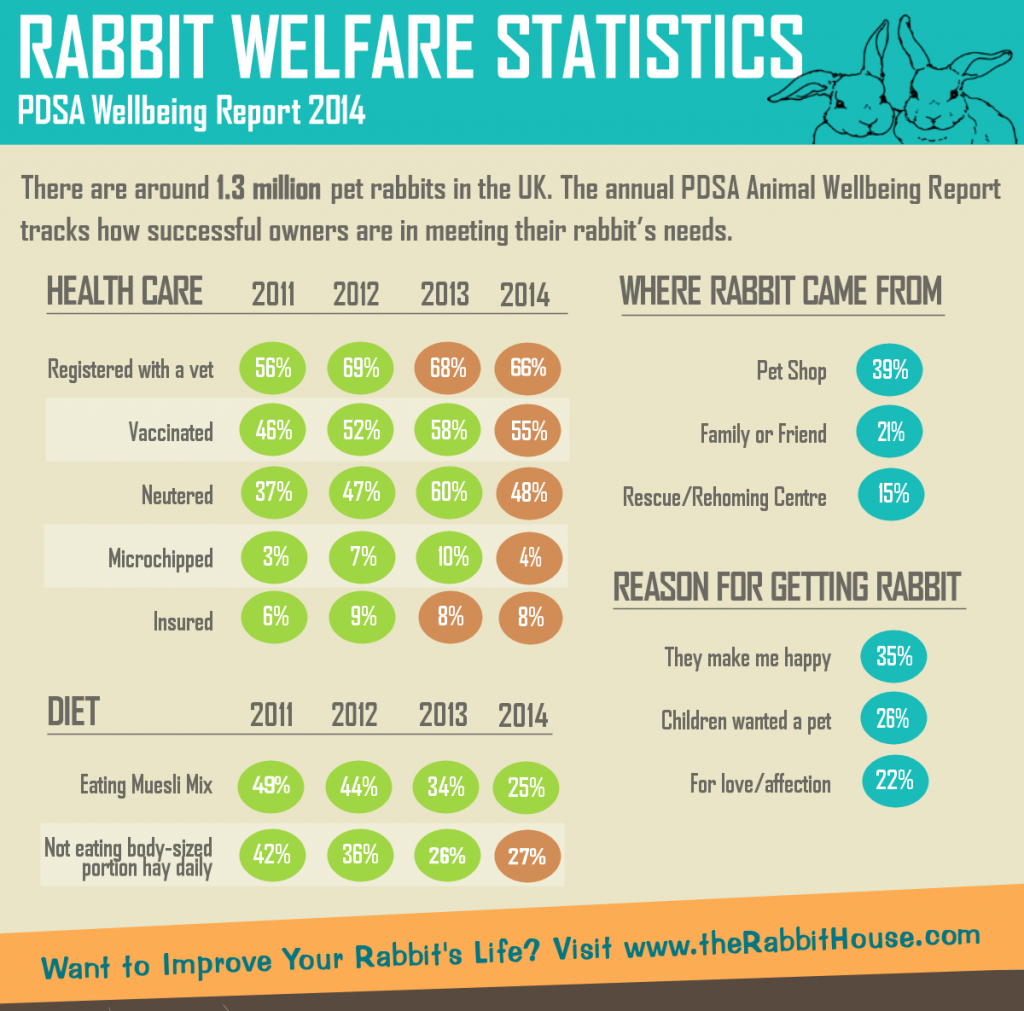Rabbit Welfare Statistics – PAW Report 2014
For the last four years the PDSA has published the PDSA Annual Well-being Report (PAW Report for short). It covers cats, dogs and rabbits and looks at welfare issues by asking pet owners and vets questions about care and welfare. You can read my summary of previous reports here: 2011, 2012, 2013.
It’s great to have these stats on things like how many rabbits are neutered and whether they get an appropriate diet because it helps welfare campaigners monitor how successful they are at implementing changes and also where to target change.
So, on to this years report. Here is a handy graphically summary (feel free to share):
And now a few details…
Diet
One of the biggest changes is the rapid decline in muesli based dry foods. In the last four years it’s dropped from being eaten by 49% to 25% of rabbits. Interestingly it’s been a sustained change, continuing this year, not just a short term reaction to media coverage.
On the other hand in the last year there hasn’t been much progress on hay eating; the percentage not eating a good portion of hay has gone up very slightly. That might be an area that needs a little more focus. It can be tough to get rabbits not used to eating hay to make the change, it can take quite a bit more effort than picking up a different dry food brand.
One of the focuses in this years report is obesity, whilst they don’t delve into too much details specifically for rabbits, I do think it’s something that needs monitoring. It’s easy for rabbits to put on weight when eating too many pellets.
Health Care
General health care hasn’t done well over the last 12 months; the numbers of rabbits neutered/vaccinated has gone down. I’m slightly surprised about this as I’d have expected it to at least hold steady. It would be good to get vaccination stats up – cats/dogs are managing 70-80%. I think vaccination is good for more than just disease prevention, it means rabbits get an annual health check giving vets the opportunity to give advice on other subjects like neutering and diet.
Reassuringly, 91% of rabbit owners would contact their vet first thing in an emergency situation, apparently rabbit owner’s second step would be to search for help online.
Where Rabbits are Obtained & Why
This year the PDSA asked owners about where they got their rabbits: 39% came from pet shops, 21% from family and friends and 15% were rescues. Whilst 15% of rabbits being adopted from rescue isn’t bad, 24% of cats and 35% of dogs came from rescues, so I think we can do better.
On the reasons behind getting a rabbit, 26% got a rabbit because ‘children wanted a pet’. That’s 1 in 4 rabbit being bought for children and couple that with that fact that ‘children getting bored’ is one of the most common reasons rabbits are given up to rescues – I think that’s a statistic that would benefit from some work to change it.
Vet’s Opinions
When vets were asked their main concerns about rabbits they were:
1. Inappropriate Diet
2. Complete lack of care – rabbits being forgotten about
3. Dental disease
Personally, I think the main problem is getting the information out there. If you research, particularly online, there are plenty of resources on good care. But, it’s very hard to reach the people from that aren’t looking for advice or don’t know they need it.
What do you think the biggest welfare issues facing rabbits are? And do you have any ideas for tackling them?
Tags: Diet, paw, rabbit-welfare



I am very concerned about the negative effects of social media. While there are many educational opportunities in social media (this blog being one of them), I see an alarming number of “cute” pictures of swimming rabbits, rabbits being bathed, rabbits in clothing and costumes, and rabbits generally used as adorable props. There are also a disproportionate number of pictures of baby bunnies on social media, all of which may lead a prospective and uninformed bunny owner to believe that house buns are adorable little fuzzballs that sit still for pictures, can be dressed up like dolls, and otherwise serve as fun toys to play and experiment with – all the while incurring no special care. Importantly, I don’t see nearly this many pictures of dogs or cats cast in the same light – almost as if cats and dogs are genuine “pets”, but rabbits are toys.
I agree Christine, social media can be both a useful tool for education and a source of bad trends in pet care.
I guess one of the questions is does social media mean more people have been bathing rabbits or just we know about it more. If it’s the later, it’s not nice to see, but it does bring the issue to light so people can be educated.
I’ve noticed photos like that begining to get more ‘down votes’ or negative comments.
It would be good if the websites that hosted this type of content but some guidelines in place to remove content that has welfare issues.